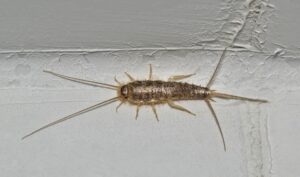Silverfish are pesky household pests that can quickly become a nuisance. These tiny, wingless insects frequent dark, damp spots in your home, like basements, bathrooms, and kitchens. Not only are they hard to look at, but they can also cause damage to books, papers, and other items made of starch or cellulose.
While many methods will send these pests packing, one practical approach you can use at home is silverfish sprays. In our blog, we’ll explore everything you need to know about silverfish sprays, from understanding how they work to choosing the right one for your needs.
Let’s get started!
The Silverfish Problem
Silverfish may seem harmless at first glance, but they can make a significant impact on your belongings. These pests have a notorious penchant for paper, targeting essential documents, books, and even pictures!

Books with glued bindings are particularly susceptible to silverfish damage. As the silverfish eat away at the glue bookbindings, the pages can become detached, and the entire book could fall apart!
Your wallpaper isn’t safe, either. Silverfish are attracted to the glue and starch content in wallpaper paste, making wallpapered surfaces susceptible to damage. They may tunnel behind wallpaper, causing it to loosen or peel away from the wall.
Cotton, linen, and silk clothing are also vulnerable to silverfish infestations. These pests may feast on items stored in dark, damp areas like dusty closets or basements. Look for irregular holes or chewed fabric edges on garments for the first signs of silverfish damage.
Their insatiable appetites and reproduction capabilities mean a small silverfish problem can escalate into a full-blown infestation if left unchecked.
Using Silverfish Sprays Effectively
Silverfish sprays function by targeting the nervous system of these pests, leading to paralysis and, eventually, death.
Common active ingredients in silverfish sprays include pyrethrins and pyrethroids, synthetic insecticides derived from chrysanthemum flowers. These ingredients are highly effective at killing silverfish on contact and have a relatively low toxicity to mammals.
To use silverfish sprays effectively, follow the manufacturer’s instructions carefully. Prepare the area first by removing clutter, vacuuming thoroughly, and sealing any cracks or crevices where silverfish may be hiding.
When applying the spray, wear protective clothing, gloves, and a mask to avoid exposure to the insecticide. Apply the spray directly to areas where silverfish are known to frequent, like baseboards, cracks, crevices, and behind appliances.
After applying the spray, allow it to dry before re-entering the treated area. Open windows and doors to further ventilate the area and circulate fresh air.
DIY Silverfish Sprays
DIY silverfish sprays can be an effective alternative to store-bought insecticides. These homemade sprays typically use vinegar, essential oils, or soap.

Vinegar and Essential Oils Spray
Mix equal parts water and white vinegar in a spray bottle for a simple DIY silverfish spray. Add a few drops of lavender or peppermint essential oil for a pleasant scent and extra pest-repelling power. Give the bottle a good shake to mix everything up, then spray it wherever you’ve spotted silverfish. It’s as easy as that!
Soap Solution
Another easy DIY trick? Mix some liquid dish soap with water in a spray bottle. When you spritz this soapy solution on spots where silverfish like to hang out, it harms their exoskeletons, making it challenging for them to survive. It’s perfect for hitting those sneaky spots like baseboards, cracks, and crevices where silverfish love to hide.
Additional Tips and Considerations
- Frequency of Application: DIY silverfish sprays may need to be reapplied regularly, especially in areas with heavy infestations or high silverfish activity.
- Targeted Application: Focus on spraying areas where silverfish frequent, like kitchens, bathrooms, and basements.
- Combination Approach: Consider using multiple DIY methods in conjunction with each other for enhanced effectiveness in controlling difficult silverfish infestations.
- Safety Precautions: While these homemade sprays are generally safe for use around people and pets, we urge you to exercise caution and avoid ingesting the solution or letting it come into contact with your eyes. Keep spray bottles out of reach of children and pets when not in use.
Eliminate Silverfish Infestations with proof.!
While DIY methods like homemade sprays can sometimes help, they might not always get the job done. These pests can be stubborn, and DIY solutions can only offer temporary relief and limited effectiveness. That’s where the pest pros come in handy!
Professional pest control techs, like the experts here at proof., have the expertise, tools, and treatments needed to tackle silverfish infestations head-on. We can assess the situation thoroughly, tailor a solution to your needs, and provide long-term relief from these pesky critters.
At proof. Pest Control, we specialize in silverfish extermination. Keep your home safe from these destructive pests by signing up for our Pest-free Guarantee program! We cover 30 common household pests, like silverfish, spiders, ants, and even bed bugs!
When you have a pest problem on your hands, you need to trust the best. Contact us today!

